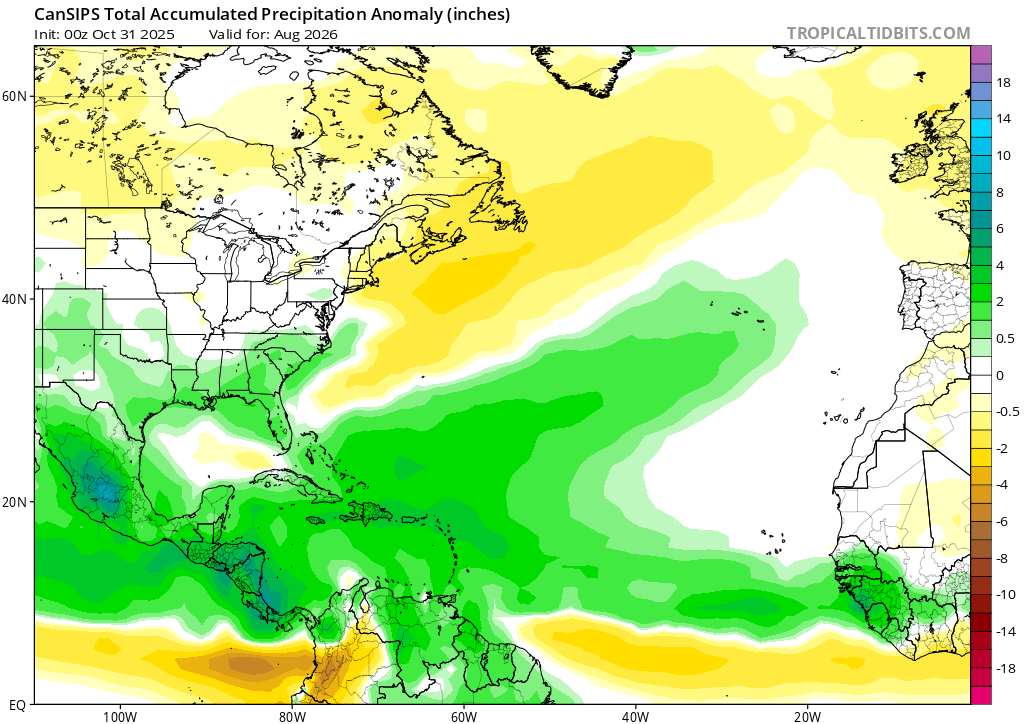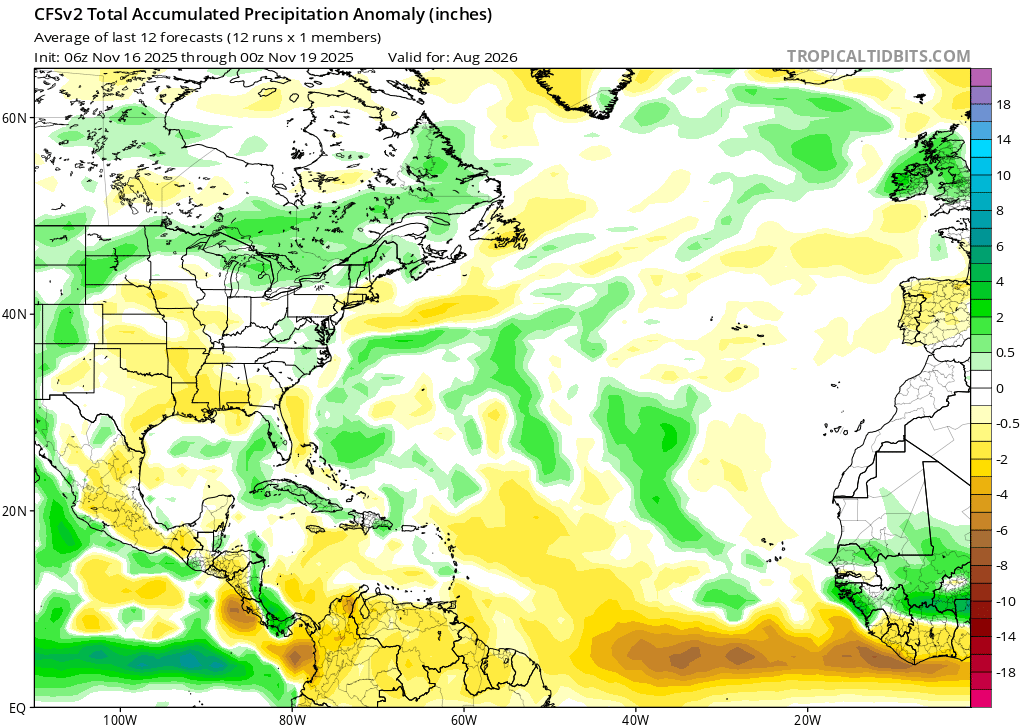

Moderator: S2k Moderators

Teban54 wrote:I just noticed the very different precipitation anomaly forecasts:
[url]https://i.postimg.cc/TYdpmjPd/cansips-apcpna-month-atl-10.png [/url]
[url]https://i.postimg.cc/wTq7J5BY/cfs-mon-01-apcpna-month-atl-9.png [/url]


Team Ghost wrote:The tropics have thrown curveballs at us these past few years. 2021, despite being a La Niña year (which one would expect to favor activity in October and November), had a late season shutdown. 2022, despite featuring a record-warm Atlantic and obvious La Niña, was only a near-average season. 2023, despite featuring a strong El Niño, was above-average in almost every single metric and even had an October hurricane form in the MDR (an exceptional feat for even a La Niña season, to say nothing of an El Niño season). 2024 was, as expected for a La Niña year with a record warm Atlantic, hyperactive, but it started unusually late compared to previous seasons and had an unusual dearth of activity from late July to early September. 2025 is shaping up to be similar to 2024 but weirder.
I cannot say what curveball 2026 will throw at us. However, given the expected onset of El Niño conditions and no sign of the African Standing Wave returning to boost activity during otherwise inactive years, I have no rational choice but to predict a below-average season. Since nothing suggests that the current +AMO regime in place since 1995 will deteriorate, my closest analogs for 2026 (expected to be a +AMO and Super El Niño year with a suppressed ASW) are 1997 and 2015. The average activity from these two seasons is 9.5 storms, 3.5 hurricanes, 1.5 major hurricanes, and 52 ACE. I have arbitrarily decided to round up the storm count and round down the hurricane and major hurricane counts because the El Niño-induced increase in vertical wind shear should make it harder than usual for storms to intensify.
Preliminary prediction for 2026:
10 storms
3 hurricanes
1 major hurricane
52 ACE

sasha_B wrote:Team Ghost wrote:The tropics have thrown curveballs at us these past few years. 2021, despite being a La Niña year (which one would expect to favor activity in October and November), had a late season shutdown. 2022, despite featuring a record-warm Atlantic and obvious La Niña, was only a near-average season. 2023, despite featuring a strong El Niño, was above-average in almost every single metric and even had an October hurricane form in the MDR (an exceptional feat for even a La Niña season, to say nothing of an El Niño season). 2024 was, as expected for a La Niña year with a record warm Atlantic, hyperactive, but it started unusually late compared to previous seasons and had an unusual dearth of activity from late July to early September. 2025 is shaping up to be similar to 2024 but weirder.
I cannot say what curveball 2026 will throw at us. However, given the expected onset of El Niño conditions and no sign of the African Standing Wave returning to boost activity during otherwise inactive years, I have no rational choice but to predict a below-average season. Since nothing suggests that the current +AMO regime in place since 1995 will deteriorate, my closest analogs for 2026 (expected to be a +AMO and Super El Niño year with a suppressed ASW) are 1997 and 2015. The average activity from these two seasons is 9.5 storms, 3.5 hurricanes, 1.5 major hurricanes, and 52 ACE. I have arbitrarily decided to round up the storm count and round down the hurricane and major hurricane counts because the El Niño-induced increase in vertical wind shear should make it harder than usual for storms to intensify.
Preliminary prediction for 2026:
10 storms
3 hurricanes
1 major hurricane
52 ACE
I feel like I agree with your premises but not your conclusion. There's more to interseasonal variation than analog years...and the fact is we've not had year below the 1991-2020 climo norm in over a decade. Though even professional forecasts have little skill at this range, and I'm just an amateur, I'd be stunned if we saw less than 12 storms, 5 hurricanes, and 2 major hurricanes in the 2026 NAtl. season. (I'm inclined to agree that '26 could be below-average relative to a *rolling* 30-year climatological period, though.)
In another thread there's been some discussion of intraseasonal forcing playing a more prominent role relative to interseasonal factors than it used to, in recent years. There's not enough data to say for sure but it seems like a fine working theory. I, like many others here, busted on my pre-season guesss for 2025 - I recall seeing plenty of calls for 16-19 named storms, and it's looking near certain that we'll close out with only 13. Below-average NS or H count is absolutely on the table. But unless we see cooling across vast swathes of the Atlantic...major hurricanes, and particularly high-end majors, are going to continue to happen (& so generate ACE) more often than they did in the 20th century, IMHO.

Team Ghost wrote:sasha_B wrote:Team Ghost wrote:The tropics have thrown curveballs at us these past few years. 2021, despite being a La Niña year (which one would expect to favor activity in October and November), had a late season shutdown. 2022, despite featuring a record-warm Atlantic and obvious La Niña, was only a near-average season. 2023, despite featuring a strong El Niño, was above-average in almost every single metric and even had an October hurricane form in the MDR (an exceptional feat for even a La Niña season, to say nothing of an El Niño season). 2024 was, as expected for a La Niña year with a record warm Atlantic, hyperactive, but it started unusually late compared to previous seasons and had an unusual dearth of activity from late July to early September. 2025 is shaping up to be similar to 2024 but weirder.
I cannot say what curveball 2026 will throw at us. However, given the expected onset of El Niño conditions and no sign of the African Standing Wave returning to boost activity during otherwise inactive years, I have no rational choice but to predict a below-average season. Since nothing suggests that the current +AMO regime in place since 1995 will deteriorate, my closest analogs for 2026 (expected to be a +AMO and Super El Niño year with a suppressed ASW) are 1997 and 2015. The average activity from these two seasons is 9.5 storms, 3.5 hurricanes, 1.5 major hurricanes, and 52 ACE. I have arbitrarily decided to round up the storm count and round down the hurricane and major hurricane counts because the El Niño-induced increase in vertical wind shear should make it harder than usual for storms to intensify.
Preliminary prediction for 2026:
10 storms
3 hurricanes
1 major hurricane
52 ACE
I feel like I agree with your premises but not your conclusion. There's more to interseasonal variation than analog years...and the fact is we've not had year below the 1991-2020 climo norm in over a decade. Though even professional forecasts have little skill at this range, and I'm just an amateur, I'd be stunned if we saw less than 12 storms, 5 hurricanes, and 2 major hurricanes in the 2026 NAtl. season. (I'm inclined to agree that '26 could be below-average relative to a *rolling* 30-year climatological period, though.)
In another thread there's been some discussion of intraseasonal forcing playing a more prominent role relative to interseasonal factors than it used to, in recent years. There's not enough data to say for sure but it seems like a fine working theory. I, like many others here, busted on my pre-season guesss for 2025 - I recall seeing plenty of calls for 16-19 named storms, and it's looking near certain that we'll close out with only 13. Below-average NS or H count is absolutely on the table. But unless we see cooling across vast swathes of the Atlantic...major hurricanes, and particularly high-end majors, are going to continue to happen (& so generate ACE) more often than they did in the 20th century, IMHO.
I would attribute the lack of a below-average season since 2015 to (a) the African Standing Wave from 2018 to 2023 creating conditions ripe for tropical cyclogenesis and (b) the years with a suppressed African Standing wave (2016, 2017, 2024, and 2025) being La Niña years. If there is both a suppressed African Standing Wave and an El Niño in 2026, a combination we have not seen in years, 2026 could absolutely be below-average relative to the 1951-2020 median.
Also, when predicting seasons months in advance, it is, for all intents and purposes, impossible to assess the impacts of intraseasonal forcing (MJO, Kelvin Wave, etc…), meaning that the only tools we have are predictions about large-scale climate patterns. There could be multiple exceptionally strong Kelvin Waves that together induce conditions favorable for the formation of over a dozen storms despite an exceptionally bad background state, but how are we supposed to know that in advance?

Category5Kaiju wrote:Team Ghost wrote:sasha_B wrote:
I feel like I agree with your premises but not your conclusion. There's more to interseasonal variation than analog years...and the fact is we've not had year below the 1991-2020 climo norm in over a decade. Though even professional forecasts have little skill at this range, and I'm just an amateur, I'd be stunned if we saw less than 12 storms, 5 hurricanes, and 2 major hurricanes in the 2026 NAtl. season. (I'm inclined to agree that '26 could be below-average relative to a *rolling* 30-year climatological period, though.)
In another thread there's been some discussion of intraseasonal forcing playing a more prominent role relative to interseasonal factors than it used to, in recent years. There's not enough data to say for sure but it seems like a fine working theory. I, like many others here, busted on my pre-season guesss for 2025 - I recall seeing plenty of calls for 16-19 named storms, and it's looking near certain that we'll close out with only 13. Below-average NS or H count is absolutely on the table. But unless we see cooling across vast swathes of the Atlantic...major hurricanes, and particularly high-end majors, are going to continue to happen (& so generate ACE) more often than they did in the 20th century, IMHO.
I would attribute the lack of a below-average season since 2015 to (a) the African Standing Wave from 2018 to 2023 creating conditions ripe for tropical cyclogenesis and (b) the years with a suppressed African Standing wave (2016, 2017, 2024, and 2025) being La Niña years. If there is both a suppressed African Standing Wave and an El Niño in 2026, a combination we have not seen in years, 2026 could absolutely be below-average relative to the 1951-2020 median.
Also, when predicting seasons months in advance, it is, for all intents and purposes, impossible to assess the impacts of intraseasonal forcing (MJO, Kelvin Wave, etc…), meaning that the only tools we have are predictions about large-scale climate patterns. There could be multiple exceptionally strong Kelvin Waves that together induce conditions favorable for the formation of over a dozen storms despite an exceptionally bad background state, but how are we supposed to know that in advance?
I see that your two analog years also happen to be the years that featured among the strongest El Ninos ever recorded (those are operationally "very strong" events). If you change your analog years to strong or even moderate events, then you'll likely get a different set of results. The reason why I say this is, I would like to ask if there's a reason why you decided not to choose El Nino years like 2002, 2006, or 2009 as analogs instead? As in, is there a specific reason why you think next year is going to see a (in the grand scheme of things, fairly rare) Super El Nino?
Users browsing this forum: hurricanes1234, Teban54 and 652 guests